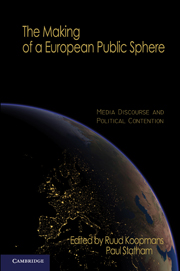Book contents
- Frontmatter
- Contents
- Tables
- Figures
- Contributors
- Acknowledgments
- Introduction
- Part I A European Public Sphere
- Part II European Public Debates
- Part III Mass Media
- 5 Making Europe News
- 6 The Media's Voice over Europe
- 7 Transnational Political Communication on the Internet
- 8 Framing the European Union in National Public Spheres
- Part IV Political Actors
- Part V Conclusion
- References
- Index
8 - Framing the European Union in National Public Spheres
Published online by Cambridge University Press: 05 June 2012
- Frontmatter
- Contents
- Tables
- Figures
- Contributors
- Acknowledgments
- Introduction
- Part I A European Public Sphere
- Part II European Public Debates
- Part III Mass Media
- 5 Making Europe News
- 6 The Media's Voice over Europe
- 7 Transnational Political Communication on the Internet
- 8 Framing the European Union in National Public Spheres
- Part IV Political Actors
- Part V Conclusion
- References
- Index
Summary
Introduction
Do Europeans share a common representation of Europe, as most research on attitudes toward European integration assumes, or do these representations vary across functional and national lines? Recent research on the topic in Spain, Germany, and the United Kingdom provides a mixed answer, by showing that some representations are shared and others are not (Díez Medrano 2003). In particular, Díez Medrano demonstrates that British frames diverge from those existing in Germany and Spain in ways that help explain British Euroscepticism. Given the rocky ratification process of recent EU reform treaties and the impact that frames have on attitudes and behavior, the task of discovering what these frames are in the largest number of European states possible has become all the more pressing. Empirical research on the topic of frames is, in fact, at the center of contemporary work in the social sciences. This interest reflects an emerging consensus about the centrality of mental representations of reality in the explanation of behavior (see the pioneering work of Tversky and Kahneman 1981). The study of European integration has not been spared from this cognitive turn in the social sciences, and scholars in this field have begun to integrate frames into their descriptions and explanations (de Vreese 2003; Menéndez-Alarcón 2004; Robyn 2005). Publicized frames occupy center stage in these discussions. Television and newspaper frames in particular are conceived both as unconscious expressions of commonly shared understandings in the population and as instrumental presentations of reality by interested media and nonmedia agents.
- Type
- Chapter
- Information
- The Making of a European Public SphereMedia Discourse and Political Contention, pp. 195 - 220Publisher: Cambridge University PressPrint publication year: 2010
- 19
- Cited by



